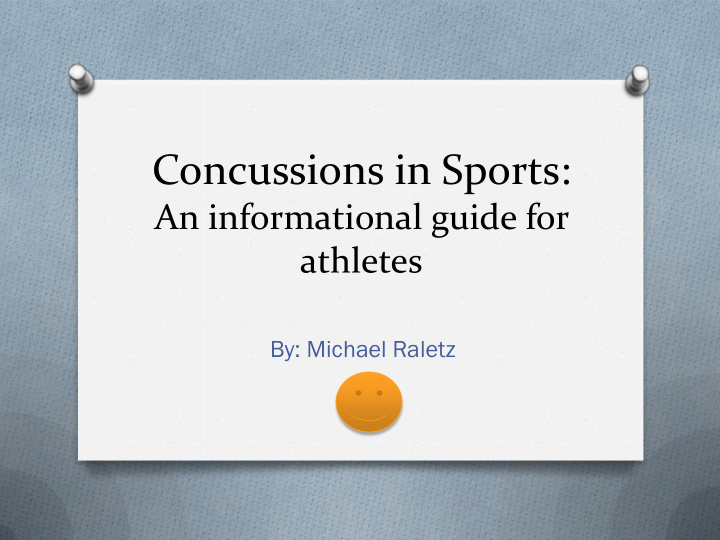



Concussions in Sports: An informational guide for athletes By: Michael Raletz
What is a Concussion? Brain Injury O An injury to the brain resulting from an impact to the head O Can be caused by a direct blow to the head or a jarring force
Epidemic in Sports O Coaches, trainers, parents, and even the athlete have trouble spotting concussion symptoms O Concussions are still slipping through and causing further injury and permanent damage.
Advancements in Sports O Enforcement on less helmet to helmet hits O Proper tackling techniques enforced O Stricter return to play guidelines O Improvements in equipment to prevent further injury
Concussion Symptoms O Headache O Blurred Vision O Ringing in Ears O Blacked Out
Concussion Symptoms (concussion) O Feeling foggy O Fatigue O Sensitivity to light O Nauseous
Concussion Symptoms (continued) O Amnesia O Dizziness O Depression O Seeing Stars O Loss of Balance O Change in Behavior O Trouble Concentrating O Trouble Sleeping
How to Spot a Concussion O Notice the mechanism of injury O Look for concussion symptoms O Ask relative questions to test memory O Check vision and hearing O ImPACT
ImPACT Concussion Test O ImPACT (Immediate Post-Concussion Assessment and Cognitive Testing) O Used to diagnose concussions and their severity O Stores patients normal scores and compares them to concussion scores
How to Prevent Concussions O Proper Equipment Fitting O Mouth Guards O Proper tackling techniques taught O Running with head up
Concussion Videos http://www.youtube.com/watch?v=fFkWTGKN LT8 http://www.youtube.com/watch?v=lqDyrTr oXdY
Post Concussion Syndrome O Post-concussion syndrome can occur when an athlete comes back from a concussion injury to soon before fully healing, and suffers a second concussion O Can cause lingering effects such as prolonged symptoms and further damage
Second Impact Syndrome O Occurs from an athlete sustaining a concussion and then goes right back into play and taking a second blow to the head O A life threatening injury that causes a hypoxic need to the brain(suffocating the brain)
Return to Play O Athletes should not be cleared to play until fully cleared by athletic trainer or a physician O Should follow the Zurich Concussion Guidelines O Six step guideline, where each step takes 24 hours and no symptoms to complete O If set back occurs during anytime, they shall return to step one and work back up
Zurich: First Step O Concussion symptoms should be gone O No Activity should be done until so
Zurich: Second Step O After 24 hours symptom free of step one, light exercise should be prescribed. O Example-Light jog or elliptical workout O No symptoms should occur
Zurich: Third Step O After 24 hours symptom free of step two, sport related exercise should be prescribed. O Example- Soccer dribbling for soccer players O Example- Football catch and light rout- running for football receivers. O No symptoms should occur
Zurich: Fourth Step O After 24 hours symptom free from step three, non-contact training drills should be prescribed. O Example- Increased intensity footwork drills O No symptoms should occur
Zurich: Fifth Step O After 24 hour symptom free from step four, full contact practice should be allowed pending clearance O No symptoms should occur
Zurich: Sixth Step O If no set back occur from steps one through five, and is cleared to play, athlete may return to play
The End
References O http://www.youtube.com/watch?v=fFkWTGKNLT 8 O http://www.youtube.com/watch?v=lqDyrTroXdY O Impacttest.com O Sterner, R. (2012). Interview by M Raletz [Personal Interview]. Lecture notes. Head Injuries, Rowan University. O Logan, K. (2010). Recognition and Management of Post-Concussion Syndrome. Athletic Therapy Today , 15 (3), 4-7. O Impacttest.com
Recommend
More recommend